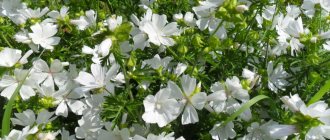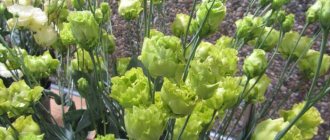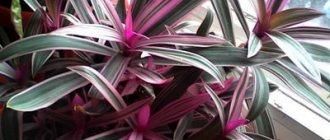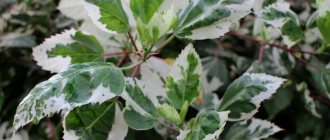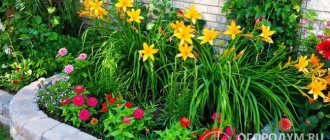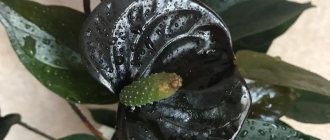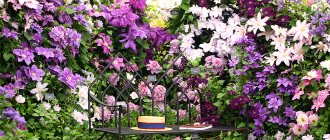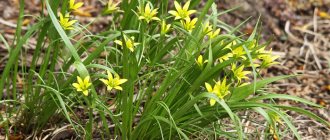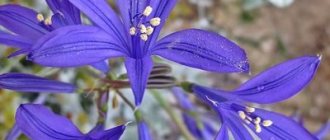Cordyline - indoor decorative flower with long red leaves
Cordyline fruticosa
This is an indoor flower with long red leaves up to 50 cm in length with red or red and white stripes. Cordyline australis has dense green leaves without petioles, some varieties with reddish or white stripes. In both species, the leaves gradually dry out from below - this is how trunks are formed.
Family: Agavaceae (Agave).
Homeland: India, New Zealand.
Location: This ornamental flower with red leaves likes light without direct sun, Cordyline australis prefers full sun.
Temperature: for Cordyline fruticosa - warm, Cordyline australis - cool.
Air humidity: ensure high humidity, spray more often.
Substrate: flower soil mixture; for Cordyline australis - with 1/3 sand.
Watering: Cordyline fruticosa - the soil should never dry out.
Feeding: once every 3 weeks, do not feed Cordyline australis in winter.
Transplantation: if necessary.
Reproduction: seeds, apical and stem cuttings.
Pests, diseases: red mite.
Important! Place Cordyline australis outside in partial shade in summer.
Look at this flower with red leaves in the photo, which illustrates its decorative capabilities:
Irezine Herbst
This perennial herbaceous plant comes from Brazil, but has long been popular in our country. It grows 40 cm in height, has a straight, strong stem and heart-shaped leaves. Their color is dark purple, and the veins are lighter.
The flower loves well-lit areas, but does not tolerate bright sun. Plant it in fertile soil and do not allow the soil to dry out, otherwise the leaves will quickly lose color. To prevent the irezine from dying in winter, you need to dig it up at the end of the season, replant it in a pot and keep it at home until next spring.
Perennial flower with red leaves
Bloom's Coleus is a perennial flower with red leaves in the middle.
The velvety leaves with finely toothed edges can come in all colors from cream, green, pink and purple to fiery red. The patterns on them are as varied as the shapes. Almost exclusively garden forms and hybrids of Coleus Bloom are grown as indoor plants. This flower with red leaves in the middle blooms with inconspicuous blue flowers.
Look at this indoor flower with red leaves in the photo and remember the name of the crop:
Family: Lamiaceae (Lamiaceae).
Homeland: Tropical Asia and Africa.
Location: a perennial flower with red leaves prefers a sunny location, otherwise the leaves will not have beautiful color.
Temperature: room temperature, in winter not lower than 12 °C.
Air humidity: the warmer the room, the higher the air humidity should be.
Substrate: flower soil mixture.
Watering: Abundant in summer, more economical at low temperatures; do not allow the earthen clod to dry out.
Feeding: Weekly in summer.
Transplantation: If necessary.
Reproduction of Coleus Bloom: Cuttings in water.
Pests, diseases: Red mite.
Important! The tops of the shoots are regularly broken off for more luxuriant growth. In the summer, expose the coleus to the air, but in damp and at the same time cold weather, bring it indoors.
Cryptanthus - home flower with red leaves
Cryptanthus acaulis has wavy red, pink or brownish leaves covered with gray scales collected in star-like rosettes. Cryptanthus bivittatus is characterized by wavy leaves with two white or pink longitudinal stripes.
Family: Bromeliaceae (Bromeliaceae).
Homeland of Cryptanthus: Brazil.
Location of home flower with red leaves: Partial shade, sunny in winter.
Temperature: Not lower than 18 °C. The earth must be warm.
Humidity: Tolerates dry air, but prefers 60% humidity. Do not spray.
Substrate: Flower soil mixture with styrene chips or something else.
Watering: Economical - in a funnel.
Feeding: In summer, every 2 weeks with fertilizer at a 50% concentration.
Transplantation: If necessary.
Reproduction: Offshoots half the size of the mother plant.
Pests, diseases: Rare.
Important! Cryptanthus should not be planted on a tree trunk as an epiphyte; it will die. Cryptanthus looks very attractive in the “bottle garden” and has a variety of uses.
Carefully! Contains substances that irritate the skin.
Reo species
The most famous are the varieties of this exotic houseplant.
Reo discolor Stripe in Pink
Distributed in all territories of the globe. Very colorful and bright, unpretentious, but requiring good lighting, the dwarf home flower reo has original colored striped leaves. The slightly silvered upper side of the leaf is decorated with pinkish stripes; the back of the leaf has a bright lilac-pink hue. The Cradle of Jesus has snow-white miniature flowers.
snow-white miniature flowers.
Lack of light negatively affects the decorative properties of reo.
Reo discolor Vittata
A highly decorative variety of medium size with amazingly colorful striped leaves. The unique combination of yellow and green parallel stripes on the front side of the leaf and the purple bottom surface makes it irresistible.
Reo discolor Compacta
It is distinguished by its chic bushiness, thanks to its bright leaves of purple-green shades.
Reo Hawaiian Dwarf
The Hawaiian gnome has original variegated foliage of a light emerald hue. Its edges are edged with snow-white stripes. The reverse side of the leaves is lilac. The year-round flowering plant produces a wonderful aroma.
Reo "Sitara Gold"
This is a new variety of flower that has warm yellow-olive leaves.
Asymmetrical greenish stripes give the plant a special decorative appearance. Taken together, this cradle of Jesus looks like tongues of flame. Looks beautiful in office spaces next to plants that have green leaves, for example, anthurium , spathiphyllum .
The name of the indoor flower with green-red leaves is Hypestes phyllospica
Only one species is cultivated as a houseplant, Hypestes phyllospica, but there are many varieties. With age, the indoor flower with green-red leaves becomes large, but bare. Olive-colored leaves usually have pink-red or white spots. Small side shoots grow from the leaf axils. A flower with green-red leaves has one name; it has no synonyms.
Hypestes is usually cultivated as an annual.
Family: Acanthaceae (Acanthaceae).
Homeland: South Africa, Madagascar.
Location: Bright, direct sun for several hours a day.
Temperature: Room temperature, not lower than 15 °C.
Humidity: High. Do not spray.
Substrate: Flower soil mixture.
Watering: Maintain moisture in summer, but not damp; water less in winter.
Feeding: Every 2 weeks, in winter once every 6 weeks.
Transplantation: Rarely.
Reproduction: Seeds; cuttings in water.
Pests, diseases: Rare.
Important! In summer, expose the hyposthes to the air in a place protected from the sun. The roots rot if the substrate is cold, so ampelous specimens are placed in a second pot with peat or styrene chips.
Reo flower care at home
It is very easy to grow an indoor reo flower at home or in the office. It requires a lot of lighting, a little heat and normal air humidity. If all the desires of the plant are brought as close as possible to wild nature, you can contemplate lush and colorful vegetation.
Direct sunlight can negatively affect the growth and development of indoor plants.
Selecting a location and temperature
Reo at home can be placed on eastern or western window sills. On the south side you need to shade the bright rays of the sun, and on the north the boat of Moses will have a pale and elongated appearance.
Reo is not a fan of cold, heat and drafts. It is advisable to maintain the winter temperature limit slightly above 13˚C, in summer - up to 25˚C.
Watering and air humidity
We water our Moses boat every three days when it gets warm, keeping the soil ball slightly moist. With the onset of cold weather, we reduce watering, and in winter - as the soil dries out.
Reo makes no demands on air humidity; he wants summer sprays at least every other day. It is not advisable to spray a flowering plant so as not to damage the flowers. During the heating season, do not place it near hot radiators. For all procedures it is necessary to use soft, warm, settled water. A grateful plant will reward you with the appearance of new strong shoots, bright colorful leaves and regular flowering.
Reo transplant and suitable soil
Annual spring transplantation of young plants into wide pots is simply necessary. Older specimens are replanted after five years, updating them with young cuttings. The bottom of the pot is covered with a good layer of drainage to prevent the presence of excess water in the pot.
The substrate should be easily breathable. You can buy soil mixture for deciduous trees at the store. A self-prepared substrate should have the following composition: leaf, turf, humus soil and sand. Take all ingredients equally.
Reo reproduction
How can you propagate reo at home? A question arises for flower growers. This important moment in the life of a flower is carried out in the spring. Young cuttings can be rooted in a damp peat-sand mixture and then transplanted to a permanent place.
Reo can be propagated by dividing the bush. We create the conditions of a mini-greenhouse and water it abundantly. We get a positive result.
With the simple seed propagation method, the varietal qualities of the plant can be lost.
Top dressing
To enhance plant growth in the warm season, it is necessary to feed Jesus' cradle with liquid complex fertilizer at half the rate.
Rheo diseases and pests
Scale insects or spider mites can harm Tradescantia reo. Excess moisture can lead to negative consequences such as powdery mildew or gray rot. If such misunderstandings are identified, we immediately apply insecticides.
Difficult moments of keeping reo
- Why do the ends of rheo leaves dry out? The room is too dry and hot; the plant may need watering.
- Leaves lose color or turn yellow, their growth slows down - too much light, the result of sunburn.
- The stems are elongated, the leaves are not densely arranged, which turn from variegated to pure green - low lighting.
- Young leaves are small and pale - they need feeding.
- Drooping and soft leaves - the room is very cold or there is excessively high humidity.
Reo juice is poisonous.
We looked at the main points on how to care for a reo flower at home. Thanks to a beautiful indoor flower, you can diversify the atmosphere of any room, decorate it and inspire creativity.
Irezine - a home flower with red-green leaves (with photo)
Irezine
Not only is it a very unassuming flower with red and green leaves, but it is also a cheerful splash of fiery red among other species. Within a year, the young plant forms a dense bush about 30 cm high with soft stems and red leaves. The following types of home flower with red-green leaves are most often on sale: Herbst's iresine (Iresine herbstii) and Linden's iresine (Iresine lindenii).
Look at the flower with red-green leaves in the photo, where the crop is shown in a variety of floral compositions:
Family: Amaranthaceae (Amaranthaceae).
Homeland: South America.
Location: As bright as possible. With a lack of light, the brightness of colors is lost.
Temperature: Room temperature is preferable, not lower than 15 °C.
Air humidity: Does not tolerate too dry air.
Substrate: Flower soil mixture.
Watering: Just maintain moisture.
Feeding: Every week in summer, once every 6 weeks in winter.
Replanting: Every year young plants develop intensively, old ones become unsightly.
Pruning: Trim the tops of young trees more often to encourage bushier growth.
Reproduction: Cuttings in water.
Pests, diseases: Rare.
Neoregelia
Narrow sword-shaped leaves form a flat rosette. During flowering, the leaf color of most species clearly changes: in some the tips of the leaves become bright red (Neoregelia spectabilis), in others the leaves in the center of the rosette turn red (Neoregelia carolinae). The unusual beautiful color lasts for months. Plants are hung on trunks and cultivated as epiphytes.
Family: Bromeliaceae (Bromeliaceae).
Neoregelia's homeland: Brazil.
Location: Bright, some sun.
Temperature: Room temperature, in winter also not lower than 18 °C.
Air humidity: Quite high. Do not spray, provide artificial humidity.
Substrate: Low-fertility, peat with styrene chips, as for epiphytes.
Watering: Use soft water in a funnel, the substrate is moist.
Feeding: Every 2 weeks with half the concentration, also in a funnel.
Replantation: Not required.
Reproduction: Offspring.
Pests, diseases: Rare.
Important! Every 2 weeks, drain the old water from the funnel and add new water.
How to prolong the pleasure - propagating Guzmania
Growing this tropical beauty is easy. But there comes a time when the flower dies and the plant loses its decorative effect. You can preserve the “tropical paradise” if you know how Guzmania reproduces .
Even during the flowering period, the plant forms a “baby” - usually one. The young flower grows very quickly and by the time the “parent” dies, it will already reach 15 centimeters in height. It is easy to know that a plant is ready to divide: the bract begins to dry out and the leaves turn pale.
Important! Before dividing, check that the children have roots. If they grow poorly, remove the peduncle in advance - this will stimulate their development.
After the mother plant withers, the children can be separated - this is done with a sharp knife. Baby Guzmania should be immediately planted in the prepared substrate, and the pot should be small, because the plant is small. Remember to use drainage to prevent your young plant from dying from overwatering. Reproduction of Guzmania is not difficult, so very soon you will be delighted with new bright flowers.
Anthurium - how to grow, how to care for, how to propagate. This indoor flower is called male happiness, and it is believed that it brings love and harmony between spouses to the house.
It turns out that aloe can be grown not only for health, but also for beauty. More details can be found here.
What to do with the huge aerial roots of indoor monstera? The answer to this question can be found at the link www.razmnojenie.ru/botanika/komnatnye-rasteniya/monstera.html.
Delaway's purple bergenia
A beautiful flower with very showy dark purple foliage that will create a special atmosphere in your garden. Bergenia will decorate rock gardens and recreation areas, as it can grow in large garden flowerpots.
Bergenia can also be an excellent option for marking the boundaries of a site, decorating flower beds and borders. It grows well in sunny and semi-shaded places, but does not tolerate stagnant water.
Begonia Semperflorence
This variety of begonia is compact, lush and has interesting colors. Its leaves can be brown, bright green or dark burgundy. The plant will be an excellent garden decoration and can be grown in shallow flowerpots.
Begonia is demanding on soil composition and needs regular and abundant watering. Plant it in the flowerbed no earlier than mid-May to protect the plants from frost.
Amaranth Early Splendor
Amaranth leaves evoke admiration and surprise - they are dark, almost black below, and bright crimson above. It loves warmth and grows well in sunny areas, also do not forget about regular watering and fertilizing.
Amaranth does not tolerate cold and frost well and begins to wither when the temperature drops slightly. Therefore, it makes no sense to leave it for the winter, since in the spring the plant will need to be planted again.
